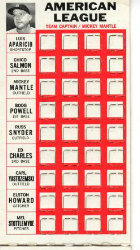Below are short bits & pieces on sportscard & baseball trading card collecting.
Please wander around the website for more info, prices, values & images
on vintage baseball, football, basketball, hockey, sport and non-sports cards.

1954 Bowman Baseball
Cards Checklist & Values
Competition was raging between Topps and Bowman in 1953 and 1954 leading to
problems with both companies sets. Bowman caused Topps to missing 6 cards
in 1953 with Topps getting revenge by signing Ted Williams to an exclusive
contract in 1954. Bowman then had to pull Ted Williams card #66 from their
set shortly after they started printing, replacing it with Jimmy Piersall,
who also was on card #210 making the 1954 Bowman Ted Williams #6
one of 50's scarcest cards.
 Perhaps distracted by it's competition with Topps, the 1954 Bowman set was
filled with errors and variations. Nearly 20% (40/224 cards) had some sort
of variation, with some having more than 2.
Perhaps distracted by it's competition with Topps, the 1954 Bowman set was
filled with errors and variations. Nearly 20% (40/224 cards) had some sort
of variation, with some having more than 2.
The St. Louis Browns recent move to Baltimore also made things interesting.
Bowman's artists had no idea what an Orioles jersey would look like -
so they just madeone up.
 TOP ROOKIES: Don Larsen, Harvey Kuenn, Frank Thomas
TOP ROOKIES: Don Larsen, Harvey Kuenn, Frank Thomas
TOP STARS: Mickey Mantle, Willie Mays, Yogi Berra, Duke Snider,
Roy Campanella, Whitey Ford, Phil Rizzuto ...
Ted Williams is not considered part of a complete set.
Click for complete
1954 Bowman Baseball card checklist, values and prices.
Note: You may be on that page right now.
|

Auction's most costly vintage baseball cards




The history of vintage baseball card auctions is long and colorful.
T-206 Honus Wagner tobacco cards have sold for upto $2.8 million in
auction. The "Holy Grail of Sports Cards", it's extreme-high auction
value can mostly be attributed to great PR and "auction fever".
It's not close to being the rarest baseball card and Honus Wagner is not
Babe Ruth or Mickey Mantle. Yes, the T-206 set is beautiful & special but
because of the # of cards and scarcities, few collector's try to complete,
which should keep auction competition down compared to say 1933 Goudey
or 1952 Topps baseball card issues.
BUT IT DOES NOT...
There's a story Wagner banned his card because he was anti-tobacco
but there are other stories about financial considerations.
You surely have heard of PSA and may even know that this card was the
FIRST they ever graded. But did you know that dealer (B.l. .ast.o name
encoded) admitted tampering with the card, perhaps having it trimmed
down to size, before PSA graded it so highly for the auction.
|

Top Vintage Baseball Card Auction Companies

There are more auction companies/houses than you can shake a stick at.
Some offer inexpensive smaller groups and individual items while others
offer massive groups with the average auction ticket price into the thousands.
- www.Baseball-Cards.com (what, you thought I'd leave myself off my list?)
- Huggins and Scott Auction House
- Heritage Auctions
- Lelands Sports Memorabilia and Card Auctions
- Pristine Auctions
- Clean Sweep Auctions
- SCP Auctions
- Sotheby's Auctions
Click for more info on my Weekly Vintage Baseball & Football card auctions
|

Tobacco Cards
Starting approximately in 1886, sportscards, mostly baseball cards, were often
included with tobacco products, for promotional purposes and also because the
card reinforced the packaging and protected cigarettes from damage. These sports
cards are referred to as tobacco cards in the baseball card hobby. Over the next
few years many different companies produced baseball cards. Tobacco cards soon
started to disappear as the American Tobacco Company tried to develop a monopoly
by buying out other companies.
They were reintroduced in the 1900s, as American Tobacco came under pressure from
antitrust action and Turkish competition. The most famous and most expensive,
baseball card is the rare T206 Honus Wagner. The card exists in very limited
quantities compared to others of its type because Wagner forced the card to be
removed from printing. It is widely (and incorrectly) believed that Wagner did
so because he refused to promote tobacco, but the true explanation lies in a
dispute over compensation.
Soon other companies also began producing baseball and football cards. Sports magazines
such as The Sporting News were early entries to the market. Candy manufacturers
soon joined the fray and reflected a shift toward a younger target audience for cards.
Caramel companies were particularly active and baseball cards were one of the first
prizes to be included in Cracker Jacks. World War I soon suppressed baseball card
production.
© 1995-2019 "InterNet's Baseball Card Store" / Joseph Juhasz ... All Rights Reserved
|








